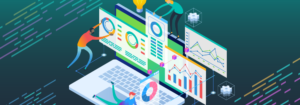Modern, tech-enabled innovations are demonstrating immense potential to transform the way healthcare is planned, delivered and paid for in the United States—but how much do you know about how these innovations really work? It can be hard to trust data-driven insights when you don’t have a clear view into how source information is being used and what analytics processes are being applied to produce those insights.
For this blog post, we sat down with David Schweppe and Matthew Hanauer on Linkedin Live to get simple explanations of a few basic data science principles. Read on to explore what is going on ‘behind the scenes’ of predictive healthcare technology.
1. Statistical modeling
Traditional statistical modeling capabilities still have their place, but the complex world of healthcare now demands more specificity and actionability than these models can offer. Next-generation statistical modeling allows providers and payers to be proactive and level up care delivery and management.
| Traditional | Next generation |
| Identifies factors contributing to particular observed phenomena | Predicts which factors may influence phenomena and explains how |
| Expands general understanding of healthcare trends and consumer behaviors | Assesses magnitude, speed, and valence of trends and behaviors to understand influence and impact |
| Equips data analysts with the information necessary to construct an action plan | Turns visible inputs into actionable outputs, allowing anyone to participate in the data-driven movement |
| Delivers answers based on averages for a specific situation | Extracts granular insights and personalized forecasts at every level—patient, community, provider, system, and industry. |
| Utilizes individual data sets or pieces together inputs from siloed sources | Presents a unified view of disparate data sources (e.g. clinical, claims, SDOH, etc.) for comprehensive understanding and effective action |
2. Cyclical processes
Data offers answers, but it also often stimulates more questions. We believe a healthy model is just that—a model. Users and leaders alike must engage fully in the cyclical process of data-driven decision making.
In this clip, Dave and Matt illustrate the iterativeness of data science using two example situations: (1) rising hypertension costs and (2) behavioral health drivers.
The beauty of this adaptability is that you can examine the same scenario from multiple angles, tweaking various factors to see what might happen and how your organization might need to adjust accordingly.
3. Why, why, and why again
Keep asking why, David says, until you get to the bottom of something. AI can suggest opportunities, identify outliers, forecast trends, and much more—but acting without full understanding is still unwise.
Our technologies and tools are not designed to be wielded thoughtlessly; there is still a critical human element at play. Dashboards are powerful summaries, but don’t be afraid to get into the nitty gritty. Drill down. Access more details. Understand the intricacies of a population health challenge by examining individual patient situations. Go deeper on denial trends to stop a problem before it becomes one. Users and leaders alike must leverage their own experiences and areas of expertise to interpret recommendations contextually and implement changes strategically.
Lightning Round!
At the end of each LinkedIn Live session, we ask our guests three quick, big-picture healthcare questions:
- What is one thing in healthcare that has you really excited right now?
- If you could solve one major challenge for healthcare organizations, what would it be?
- What is one key trend that you’re keeping an eye on? Anything we should be watching and researching?
Hear Dave and Matt’s answers:
Stay tuned on LinkedIn for more live events, timely resources, and more!
Get our take on industry trends
You’re asking too much of your EHR
Electronic Health Records (EHRs) are purported to do a lot of things to support healthcare providers, and most of their claims are generally accurate. Of course, like anything, there are many areas where EHR vendors could and should make improvements.
Read on...Gamification in healthcare only works if you can measure it – here’s how
In business and in sports, it’s all about teams. What teams can accomplish when they work together. How they can fail spectacularly when they do
Read on...Pandemic fuels 2021 healthcare megatrends
When I wrote about megatrends last year, the predictions were, naturally, forward-looking. Telehealth, for example, was important because of increased healthcare consumerism and the convergence of technologies to make its use quick and easy for payers, providers and patients.
Read on...Measuring provider cost and utilization
No matter the time of year, payers and providers should work to agree on a shared source of truth when it comes to data. With the recent end of the year, it’s time to celebrate the new year (who isn’t ready to say goodbye to 2020?) and close the books, which includes the reconciliation of any shared savings or losses.
Read on...


